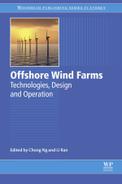[1] EWEA. Offshore Statistics January 2008. 2009. (Online). Available: http://www.ewea.org/fileadmin/ewea_documents/documents/statistics/Offshore_Wind_Farms_2008.pdf (accessed 07.10.15).
[2] Snyder B, Kaiser M.J. A comparison of offshore wind power development in Europe and the U.S.: patterns and drivers of development. Appl. Energy. October 2009;86(10):1845–1856.
[3] EWEA. Offshore Statistics 2014. 2015. (Online). Available: http://www.ewea.org/statistics/offshore-statistics/ (accessed 07.10.15).
[4] Global Wind Energy Council (GWEC). Global Offshore. 2015. (Online). Available: http://www.gwec.net/global-figures/global-offshore/ (accessed 07.10.15).
[5] EWEA. The European Offshore Wind Industry – Key Trends and Statistics 2014. 2015. (Online). Available: http://www.ewea.org/fileadmin/files/library/publications/statistics/EWEA-European-Offshore-Statistics-2014.pdf (accessed 07.10.15).
[6] Ernst & Young. Offshore Wind in Europe Walking the Tightrope to Success. 2015. (Online). Available: http://www.ewea.org/fileadmin/files/library/publications/reports/EY-Offshore-Wind-in-Europe.pdf (accessed 07.10.15).
[7] CIGRE TB 610. Offshore Generation Cable Connections. 2015 Paris.
[8] BVG Associates. Offshore Wind: A 2013 Supply Chain Health Check. 2013. (Online). Available: http://www.bvgassociates.co.uk/Portals/0/publications/BVGATCE Offshore Wind SC Health Check 1311.pdf (accessed 28.03.15).
[9] Lakshmanan P, Liang J, Jenkins N. Assessment of collection systems for HVDC connected offshore wind farms. Electr. Power Syst. Res. December 2015;129:75–82.
[10] Pan J, Bala S, Callavick M, Sandeberg P. DC connection of offshore wind power plants without platform. In: 13th Wind Integration Workshop. 2014.
[11] BVG Associates. Building an Industry 2013: Updated Scenarios for Industrial Development. 2013. (Online). Available: http://www.renewableuk.com/en/publications/index.cfm/BAI2013 (accessed 28.03.15).
[12] BVG Associates. UK offshore Wind Supply Chain: Capabilities and Opportunities. 2014. (Online). Available: https://www.gov.uk/government/uploads/system/uploads/attachment_data/file/277798/bis-14-578-offshore-wind-supply-chain-capabilities-and-opportunities.pdf (accessed 28.03.15).
[13] Chen W, Huang A.Q, Li C, Wang G, Gu W. Analysis and comparison of medium voltage high power DC/DC converters for offshore wind energy systems. IEEE Trans. Power Electron. April 2013;28(4):2014–2023.
[14] ABB. HVDC MI Cables. 2014. (Online). Available: http://new.abb.com/systems/high-voltage-cables/cables/hvdc-mi-cables (accessed 03.09.14).
[15] National Grid. Electricity Ten Year Statement. 2012. (Online). Available: http://www.nationalgrid.com/NR/rdonlyres/DF56DC3B-13D7-4B19-9DFB-6E1B971C43F6/57770/10761_NG_ElectricityTenYearStatement_LR.pdf (accessed 08.06.15).
[16] FOSG. Roadmap to the Supergrid Technologies Final Report. March 2011. (Online). Available: http://mainstream-downloads.opendebate.co.uk/downloads/FOSG_WG2_Final-report.pdf (accessed 31.10.12).
[17] SKM. Review of Worldwide Experience of Voltage Source Converter (VSC) High Voltage Direct Current Technology (HVDC) Installations. 2013. (Online). Available: https://www.ofgem.gov.uk/ofgem-publications/52726/skmreviewofvschvdc.pdf (accessed 18.02.15).
[18] Rudervall R, Charpentier J.P, Sharma R. High voltage direct current (HVDC) transmission systems technology review paper. Energy Week 2000. 2000. (Online). Available: http://www2.internetcad.com/pub/energy/technology_abb.pdf (accessed 20.04.15).
[19] Flourentzou N, Agelidis V.G, Demetriades G.D. VSC-based HVDC power transmission systems: an overview. IEEE Trans. Power Electron. March 2009;24(3):592–602.
[20] N. MacLeod, Enhancing System Performance by Means of HVDC Transmission (Online). Available: http://www.pbworld.com/pdfs/pb_in_the_news/gcc_power_paper_a095.pdf (accessed 22.02.14).
[21] Du C. The Control of VSC-HVDC and Its Use for Large Industrial Power Systems. 2003. (Online). Available: http://publications.lib.chalmers.se/records/fulltext/11875.pdf (accessed 08.04.15).
[22] Alstom Grid. HVDC – Connecting to the Future, First. Levallois-Perret Cedex: Alstom Grid; 2010.
[23] Liu C.-C, He L, Finney S, Adam G.P, Curis J.-B, Despouys O, Prevost T, Moreira C, Phulpin Y, Silva B. Preliminary Analysis of HVDC Networks for Off-shore Wind Farms and Their Coordinated Protection. 2011. (Online). Available: http://www.twenties-project.eu/node/18 (accessed 19.04.15).
[24] Justin G. Siemens Debuts HVDC PLUS with San Francisco's Trans Bay Cable. Living Energy; 2011. (Online). Available: http://www.energy.siemens.com/hq/pool/hq/energy-topics/publications/living-energy/pdf/issue-05/Living-Energy-5-HVDC-San-Francisco-Trans-Bay-Cable.pdf (accessed 18.11.14).
[25] ERDF. Irish Scottish Links on Energy Study (ISLES) Technology Roadmap Report. 2012. (Online). Available: http://www.scotland.gov.uk/resource/0039/00395552.pdf (accessed 18.02.15).
[26] Soeiro T.B, Kolar J.W. The new high-efficiency hybrid neutral-Point-clamped converter. IEEE Trans. Ind. Electron. May 2013;60(5):1919–1935.
[27] Siemens. High Voltage Direct Current Transmission – Proven Technology for Power Exchange. 2015. (Online). Available: http://www.siemens.com/about/sustainability/pool/en/environmental-portfolio/products-solutions/power-transmission-distribution/hvdc_proven_technology.pdf (accessed 31.0315).
[28] Siemens. The Sustainable Way: Grid Access Solutions Form Siemens. 2011. (Online). Available: http://www.energy.siemens.com/co/pool/hq/power-transmission/grid-access-solutions/landingpage/Grid-Access-The-sustainable-way.pdf (accessed 21.04.15).
[29] Jacobson B, Karlsson P, Asplund G, Harnefors L, Jonsson T. VSC-HVDC transmission with cascaded two-level converters. In: Cigré 2010 Session. 2010 (accessed 20.04.15).
[30] Das D, Pan J, Bala S. HVDC light for large offshore wind farm integration. In: 2012 IEEE Power Electronics and Machines in Wind Applications (PEMWA). 2012:1–7.
[31] ABB. Skagerrak. 2014. (Online). Available: http://new.abb.com/systems/hvdc/references/skagerrak (accessed 18.08.14).
[32] Ahmed N, Haider A, Van Hertem D, Zhang L, Nee H.-P. Prospects and challenges of future HVDC SuperGrids with modular multilevel converters. In: Proceedings of the 14th European Conference on Power Electronics and Applications (EPE 2011). 2011:1–10.
[33] Dorn J, Gambach H, Strauss J, Westerweller T, Alligan J. Trans Bay Cable – a breakthrough of VSC multilevel converters in HVDC transmission. In: Cigré Colloquium – HVDC and Power Electronic Systems for Overhead Line and Insulated Cable Applications. 2012.
[34] Modeer T, Nee H.-P, Norrga S. Loss comparison of different sub-module implementations for modular multilevel converters in HVDC applications. In: Proceedings of the 14th European Conference on Power Electronics and Applications (EPE 2011). 2011:1–7.
[35] ABB. DolWin1. 2013. (Online). Available: http://new.abb.com/systems/hvdc/references/dolwin1 (accessed 18.08.14).
[36] Blasco-Gimenez R, Añó-Villalba S, Rodríguez-D'Derlée J, Morant F, Bernal-Perez S. Distributed voltage and frequency control of offshore wind farms connected with a diode-based HVdc link. IEEE Trans. Power Electron. December 2010;25(12):3095–3105.
[37] Bernal-Perez S, Ano-Villalba S, Blasco-Gimenez R, Rodriguez-D'Derlee J. Efficiency and fault ride-through performance of a diode-rectifier- and VSC-inverter-based HVDC link for offshore wind farms. IEEE Trans. Ind. Electron. June 2013;60(6):2401–2409.
[38] Menke P. New grid access solution for offshore wind farms. In: European Wind Energy Association (EWEA) Conference. 2015. (Online). Available: http://www.ewea.org/offshore2015/conference/allposters/PO208.pdf (accessed 20.04.15).
[39] Friends of the Supergrid (FOSG). Roadmap to Supergrid Technologies – Update Report. 2014. (Online). Available: http://www.friendsofthesupergrid.eu/wp-content/uploads/2014/06/WG2_Supergrid-Technological-Roadmap_20140622_final.pdf (accessed 21.08.14).
[40] Hörle N, Asmund M, Eriksson K, Nestli T. Electrical supply for offshore installations made possible by use of VSC technology. In: Cigré 2002 Conference. 2002.
[41] Haileselassie T.M, Uhlen K. Power system security in a meshed North sea HVDC grid. Proc. IEEE. 2013;101(4):978–990.
[42] Alstom. Alstom Takes World Leadership in a Key Technology for the Future of Very High Voltage Direct Current Grids. 2013. (Online). Available: http://www.alstom.com/press-centre/2013/2/alstom-takes-world-leadership-in-a-key-technology-for-the-future-of-very-high-voltage-direct-current-grids/ (accessed 22.04.13).
[43] ABB. The High Voltage DC Breaker – The Power Grid Revolution. 2012. (Online). Available: http://www04.abb.com/global/seitp/seitp202.nsf/c71c66c1f02e6575c125711f004660e6/afefc067cd5a69c3c1257aae00543c03/$FILE/HV+Hybrid+DC+Breaker.pdf (accessed 22.04.13).
![]() [14.1]
[14.1]
![]() [14.2]
[14.2]![]() [14.3]
[14.3]![]() [14.4]
[14.4]![]() [14.5]
[14.5]![]() [14.6]
[14.6]![]() [14.7]
[14.7]











